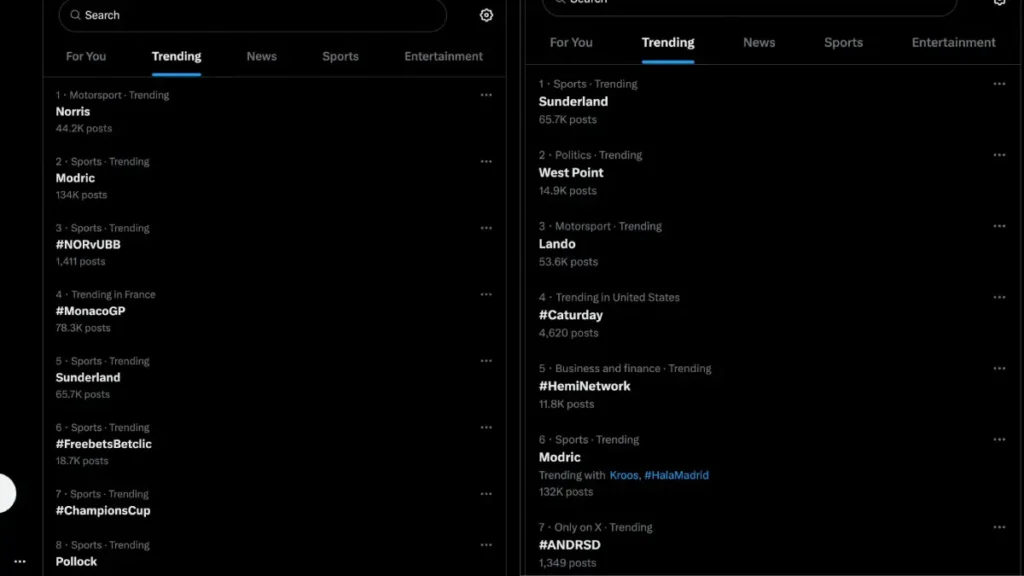
While most of us use Twitter to grow our businesses, the truth is that Twitter, at its core, was not designed for that reason.
𝕏 is more of a real-time news coverage platform.
So, how do creators or business owners like us use Twitter – which is primarily built for news coverage – to grow our businesses?
In this article, I share the exact strategies I use to get consistently millions of impressions by riding emerging trends, aka newsjacking.
Let’s get started.
What Are Twitter Trends and Why Do They Matter in 2025

Before we dive into how to take advantage of Twitter Trends, let’s go over what they are and how they’re created.
So, in order to understand exactly how trends are created, you should first understand how the 𝕏 algorithm works.
Of course, the 𝕏 algorithm is very sophisticated and complex, and understanding exactly how it works is not easy, but I will do my best to explain this process as simply as possible.
Step 1: Detecting the Surge
As we mentioned in the previous paragraph, 𝕏 is more like a real-time news coverage platform.
So, how does the algorithm understand when a topic starts emerging?
It all starts by constantly scanning public tweets and detecting sudden spikes in activity.
The geeky name of this process is engagement velocity, and it’s the number one signal for detecting emerging trends.
Step 2: Semantic Entity Recognition
If you have been into SEO, you probably know about what semantics is, but if you don’t, let me explain it to you really fast.
In simple words, semantics is the process AI search engines and algorithms use to understand the meaning of a word and its connections to other related words.
And this is exactly what the Twitter algorithm does at this point.
It uses NLP (natural language processing) and entity recognition to understand what these words actually mean and what people talk about, even if they don’t use the exact same words.
For example, if it detects a surge on keywords like Elon Musk, Musk, Elon, X owner, Tesla CEO, or SpaceX owner, Twitter, through this NLP analysis, can understand that all these keywords are about Elon Musk.
This is very important as this grouping helps the Twitter algorithm create accurate trends and not dilute a trend into smaller ones cause of similar words.
Step 3: Filtering and Threshold Checks
So, after a topic is detected and grouped by the algorithm, it still won’t appear in the trending tab yet.
It will go through a complex filtering system to make sure it’s safe, legit, and relevant.
Here is the process:
- Engagement Velocity Threshold
Twitter has a certain threshold for adding a topic to trends.
In this stage, it evaluates if the engagement velocity hits its threshold number.
This means:
- Gaining significant traction in a very small timeframe.
- Beat the threshold levels
- Get more traction than similar topics
- Trigger engagement from a diverse user base, not a few big accounts (to avoid manipulation)
- Content Safety Filtering
Now that Twitter’s algorithm is sure about the realness of the trend, it’s time for a final check that ensures the safety of the users
This safety process filters out:
- Spam (irrelevant or misleading content)
- Misinformation or fake news (at this point, Twitter’s algorithm fact-checks the context of the tweets by using internal and external fact-checking mechanisms)
- Toxicity (if this topic has a lot of hate or inappropriate language or graphics, it gets filtered out.
Step 4: Personalized Distribution
After a topic has passed all these tests and is officially a trend, it doesn’t mean you will see it in your trending topics tab.
This happens because the trending tab is personalized based on a user’s location and behavior.
Here’s how it works:
- Localization
The first and most important personalization signal is your location.
Depending on the country you are in, Twitter’s algorithm will blend a mix of local and global trends and show them in your trending topics tab.
You can easily test that by using a VPN and clicking on your trending topic tab.
Depending on the country you choose for your VPN service, you will see completely different topics.
- Behavior-Based Personalization
The second signal 𝕏 uses to curate your trending topics tab is your actual behavior.
This means that 𝕏 will analyze:
- Follows (who you follow and what niche they are in)
- Interactions (the content that you engage with, like content you like, reply to, or share)
- Search history (what have you looked for in the Twitter search bar)
- Your language (if you interact with content in a non-English language, Twitter will serve you Trends in this language.)
Bonus: How Elon Musk Changed the Twitter Algorithm (and Why It Matters)
A major update to the recommendation algorithm is rolling out over the next few days.
— gorklon rust (@elonmusk) November 10, 2023
This will help surface smaller accounts and posts outside of your friend-follows network.
As always, this will be made open source and undergo continuous improvement.
After Elon took Twitter aggressively in 2022, the first thing he did was to rebuild all the logic of the platform.
He focused on promoting free speech, user empowerment, and real-time relevance.
He changed literally everything from how content distribution works to the reach of the trends, and much more.
But what does that mean to you as a creator?
1. Real-Time Content > Evergreen
The first and most important thing that affects creators is that Elon prioritized the broader distribution of live unfolding events.
This means you will get much more reach by talking about topics of unfolding events and breaking news than by publishing evergreen content.
- Citizen Journalism Model
When Twitter rebranded into 𝕏 after getting acquired by Elon, the biggest change he made was presenting Twitter as a “citizen journalism” platform.
This means that the 𝕏 platform now promotes original content and commentary from smaller accounts and regular users instead of legacy media accounts.
Why This Matters
If you are a creator, a personal brand, or a small business using Twitter to get more leads and clients, Elon’s updates made the game easier for you.
If you act fast when trends emerge, add a personal take on it, and write like who you really are and not like a corporate account, you have way better chances of reaching a wider audience than you had before Musk took over.
Where to Find Trends (Before They Explode)

This is the step where I think a lot of people overcomplicate things.
They either try to find a “secret tool” that will spot trends or go to the other end and search online for hours.
My strategy for finding good trends is dead simple.
The first thing I do is turn on my VPN to the major English-speaking countries like the USA, UK, and Canada, and each time, I check the trending topics section.
Then I use a blank account (you should definitely have a blank Twitter account, meaning you do nothing with it, just checking things out) and go through the same process.
This takes me no more than 10 minutes.
When done, I look for common topics and then visit Google to see what these breaking news stories are really about.
At this point, I use my own judgment to decide if I should create content on a specific topic, and what angle to use.
The Newsjacking Framework in 4 Steps

By now, you know exactly how Twitter’s algorithm works, how trends are created, and why it’s important to use them.
Now it’s time to learn how to create Newsjacking posts.
Step 1: Find trending topics
In the previous section, I shared my exact process on how to spot trends, so there is not much more to say. Let’s move into Step number two.
Step 2: Add Your Unique Angle
Let’s use a real-life example to make it more interesting.
I am in the personal branding – online business niche.
Should I cover a trend about Trump adding tariffs to Europe, and if so, how do I do it?
This is what is known as an angle in the advertising world, meaning how you approach a certain topic.
- Directly commenting on the topic
If these tariffs affect my audience of solo founders and creators, then I can directly cover this topic by adding my opinion about it and explaining in depth how it will affect them.
The most common mistake people make when covering a topic directly is trying to please everyone and not expressing a bold opinion.
This is completely wrong cuz
a) It’s bad for your brand: A strong brand should have strong views on things, and
b) It’s bad for reach: If you express a very bold opinion, people in the comments section will have a battle (some will be with you and some against), which will trigger engagement signals to the algorithm, boosting your post even more.
- Getting Creative
The truth is that 90% of the time, the trending topics won’t be a great fit for direct commenting as they won’t be the main concern of your target audience.
And these are the times when you need to start getting creative.
So let’s get back to our tariffs example.
Now, the truth is that the majority of my audience (and probably yours) won’t care much about this as they are not exporters or ecommerce owners, so how do I cover this?
It’s time to put your creative hat on and explore some possible angles.
One angle here is to cover it by talking about Trump himself.
I do a lot of business threads (and my audience is used to it), so if I decide to do a thread about Trump (which is an entity very close to this topic), I get the best of both worlds.
I keep the algorithm happy because I talk about an entity very close to this trending topic, and my audience too, as business threads are something they like and expect from me.
So I can definitely do a thread about something business-wise that Trump did.
To keep it even more topic-related, I can use a hook like:
“Everyone is talking about Trump’s tariffs, but what they don’t know is that in 1500, he did this X amazing thing. Here’s how he made 10.0000.0000 billions”
A second way to approach this topic is to start thinking about the broader implications of these tariffs.
Something like:
“People are getting hysterical about Trump’s tariffs, but this is the greatest chance for solo founders getting into stocks, as the stock market crashes. Here are the top 10 cheap stocks to get into right now that will moon in 2 years.”
Or I could use a more general angle that’s interesting to everyone, attracting not only my audience but also other groups.
Something like:
“Trump just started a tariff war. But it is nothing compared to what happened in the previous century. Here are the 10 biggest trading Wars in world history. No. 8 will blow your socks off.”
Finally, I could use another angle to create a business thread like:
“Europe is preparing counter tariffs as a response to Trump. Here’s what will change for the economy and business.”
As you can see, you can really get creative when deciding how to cover a trending topic.
Step 3: Publish FAST (Within the First 6–12 Hours)
As we mentioned many times throughout this post, you should work along with the algorithm and not against it.
In the first sections, I explained how trending topics are created and ranked, but I didn’t talk at all about how trends end.
When a topic surges, the algorithm continuously checks for signs of losing momentum, and when that happens, it gets deprioritized and other more trending topics take its place.
This usually happens after 16 to 24 hours (of course, not all trending topics last the same time).
What this means for you is that the best time to jump in on a trend is the first 6 to 12 hours.
This is the timeframe during which a topic is getting boosted by Twitter’s algorithm.
You don’t want to spend time doing research and creating a long thread, and then post it when the algorithm deprioritizes the topic you covered.
Step 4: Optimize Your Post
If you are a loyal follower of buildsolo.io, you already know that there are certain metas on Twitter, meaning certain types of content that the algorithm favors.
At the time of writing this article, the current meta is long threads with lots of graphics, videos, etc.
This makes complete sense as the algorithm’s job is to keep users on the platform, and long threads with media do exactly that.
But doing a long thread with media alone won’t make it.
When covering a trending topic, you are battling for attention with all the users that are covering this topic (which are way more than your usual competitors when doing an evergreen post).
So you need to nail everything: the hook, the writing rhythm, the cliffhangers, and the graphics.
If you are really serious about mastering Twitter growth, check our X growth Playbook and join the top 1% of solo creators and personal brand builders.
Bonus: Section to Hashtag or Not to Hashtag
One of the most common questions I get is whether they should use hashtags when Newsjacking or not.
The short answer is no, you shouldn’t.
Hashtags used to work in the early days of Twitter to help the algorithm understand what your content is about.
But as already mentioned, nowadays Twitter’s algorithm uses advanced technologies like natural language processing and entity recognition to understand what your post is about, so using hashtags is not necessary and tbh looks a bit cringe, too.
Newjacking trending topics is a skill, and like any skill in life, the more you practice it, the better you become at it.
So, don’t get frustrated if you do it once and it doesn’t work; do it again and again and improve on it.
But if you don’t have the time and looking for a shortcut to growing on Twitter, join the 𝕏 Growth Playbook and start growing today

George Mastorakis is a digital marketer with 12+ years of experience in building and growing online businesses. From affiliate SEO sites and CPA funnels to agency work and leading growth at Synthesys from $0 to $1M ARR, he’s done it all. Today, he helps solo founders build a personal brand and scale their businesses using startup growth tactics he’s refined through years of hands-on experience.


Leave a Reply